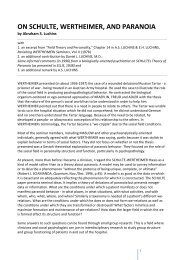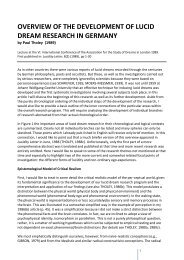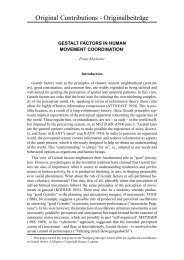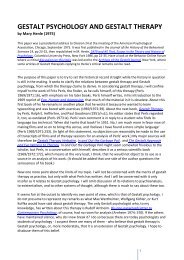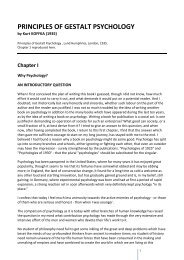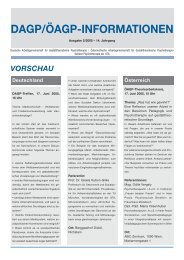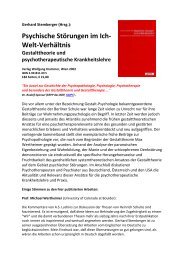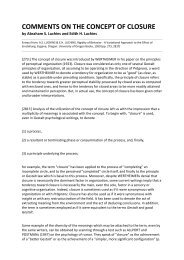pdf-Download - Society for Gestalt Theory and its Applications (GTA)
pdf-Download - Society for Gestalt Theory and its Applications (GTA)
pdf-Download - Society for Gestalt Theory and its Applications (GTA)
You also want an ePaper? Increase the reach of your titles
YUMPU automatically turns print PDFs into web optimized ePapers that Google loves.
that he was surprised to hear that WERTHEIMER's thesis of isomorphism is not like KÖHLER's.From reading KOFFKA (1935) he had the impression that WERTHEIMER originated the thesis ofneural physiological isomorphism. But it seems that WERTHEIMER actually focuses on the relationbetween the geographical <strong>and</strong> the phenomenal world, while KÖHLER focuses on the relationbetween the phenomenal <strong>and</strong> the psychophysical field. The discussants decided that neitherKÖHLER nor WERTHEIMER would deny that it sometimes happens that the phenomenal, thegeographical, <strong>and</strong> the brain field may be isomorphic.Someone said that WERTHEIMER seems more concerned than KÖHLER with truth, with veridicalperception. WERTHEIMER is aware of the lack of isomorphism in some cases <strong>and</strong> suggests that wefind out the conditions that produce non-correspondence between the percept <strong>and</strong> the aspect ofthe real world that it maps. KÖHLER's thesis does not lead to such research.Martin SCHEERER, a seminar member who had joined the discussion, said that WERTHEIMER'sthesis of isomorphism does not require a physiological theory. WERTHEIMER is pointing out thatthere are resemblances between perception <strong>and</strong> the external world. A philosophy major arguedthat WERTHEIMER would have to be a Naïve Realist to believe that what we see actually exists;what we see is often not really so!It was noted that psychology until recently was a branch of philosophy, <strong>and</strong> it has inherited themind-body problem. A refugee scholar said that the principle of isomorphism is the <strong>Gestalt</strong>psychologists solution to the mind-body problem as it was <strong>for</strong>mulated by DESCARTES. KÖHLER'sthesis has replaced metaphysical dualism with an epistemological dualism. He went on to say thatin many respects WERTHEIMER's thesis reflects SPINOZA's identity theory <strong>and</strong> PYTHAGORAS ideathat Form is immanent in the material thing. ASL (A.S. LUCHINS) commented that WERTHEIMER'sthesis of isomorphism is neutral to the question of the nature of the mind, the body, <strong>and</strong> therelation between them. His thesis calls <strong>for</strong> study of the relationship between the evidence <strong>and</strong>what one sees based on the evidence. The principles of organization provide an example of howWERTHEIMER would go about studying the relationship between the organization of thegeographical <strong>and</strong> phenomenal fields. Someone recalled that WERTHEIMER said that the laws o<strong>for</strong>ganization also hold <strong>for</strong> structuring of the brain field. SCHEERER remarked that <strong>Gestalt</strong>isomorphism frees psychologists from the idea of mysterious conscious events in the brain. Thephilosophy major argued that WERTHEIMER himself used physiological speculation to concretizehis thesis about a <strong>Gestalt</strong> as a dynamic whole in his short-circuit theory <strong>for</strong> phi movement. ASLpointed out that the neurologizing was a kind of footnote but WERTHEIMER himself claimed it wasnot essential to underst<strong>and</strong>ing of the phi phenomenon.Someone remarked that WERTHEIMER's thesis takes us back to the pre-philosophical naïve viewthat there is a correlation between the structure of objects <strong>and</strong> the structure of psychologicalexperience. ASL commented that WERTHEIMER does not say that there is always a correlationbetween the geographical <strong>and</strong> phenomenal worlds but that there are cases where there is such acorrespondence; there are also cases where there is little or no correspondence. WERTHEIMERsuggests that we study the factors involved in each case; what factors blind one <strong>and</strong> what factorsopen one's eyes to the structure of what is be<strong>for</strong>e him? Moreover, what can be done to bringabout recovery <strong>for</strong> those who are blind to the structure? WERTHEIMER's thesis calls <strong>for</strong> empiricalresearch. It involves looking <strong>for</strong> new ways to deal with the question of why things look the waythey do.The refugee scholar said that eventually WERTHEIMER's approach will have to reconcile <strong>its</strong>elf toKÖHLER's because psychology is becoming a biological science. WERTHEIMER himself realized thevalue of a neurological model when he discussed the phi phenomenon. KÖHLER is merelyfollowing in the master s footsteps with the thesis of psychophysiological isomorphism. SCHEERERinsisted that it is possible to deal with the percept <strong>and</strong> the geographical stimuli in WERTHEIMER'smanner without a neurological model. ASL said that it may even be an advantage to do this; it will7



